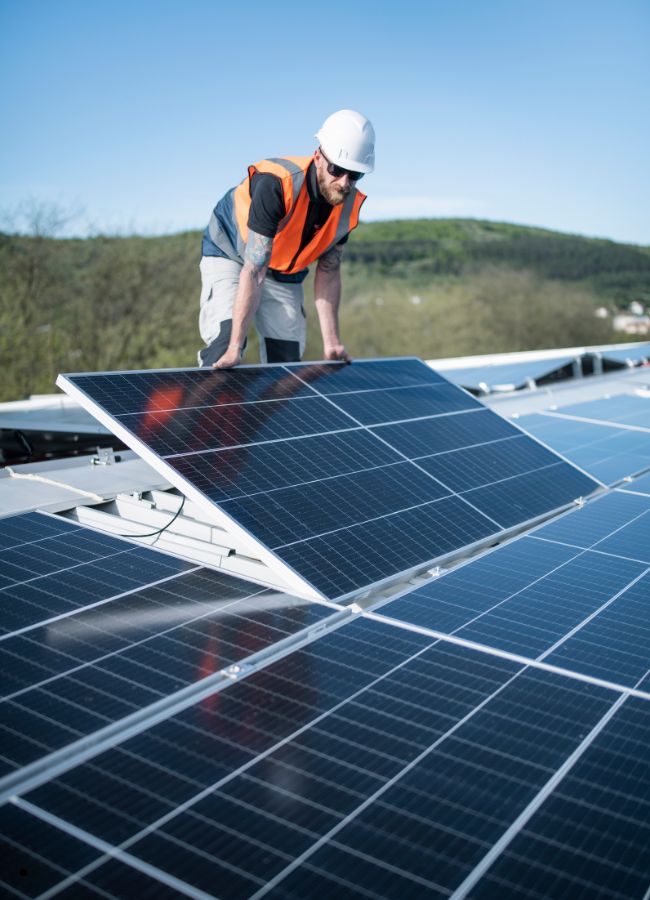Australia is a sunburnt country, and it’s no surprise that solar power has become a cornerstone of our energy landscape. With more than one in three households having rooftop solar, we’re world leaders in its adoption. But what does “solar power efficiency” really mean, and how can you make the most of it?
Beyond the Numbers: What is Solar Panel Efficiency?
In simple terms, a solar panel’s efficiency is the rate at which it converts sunlight into usable electricity. The average residential solar panel on the market today has an efficiency of 17-24%, but this is a laboratory measurement under “Standard Test Conditions.” In the real world, the power output of your system is influenced by a number of factors, including:
- Temperature: Solar panels are more efficient in cooler conditions. For every degree above 25°C, a panel’s efficiency can drop by 0.25% to 0.52%. This is a key consideration in Australia’s hot climate, and why panels with a lower “temperature coefficient” are a smart investment.
- Sunlight and Weather: While we have abundant sun, factors like cloud cover, dust, and even the angle of the sun at different times of the year affect how much energy is produced.
- Installation and Orientation: For optimal performance in the Southern Hemisphere, panels should face north. The tilt angle of your roof also plays a role, with the ideal pitch being close to your location’s latitude.
- Shading: Even partial shading from a tree, chimney, or other obstruction can significantly reduce the output of an entire string of panels.
- System Components: It’s not just about the panels. The efficiency of your inverter, the length and quality of the wiring, and even the cleanliness of the panels themselves all contribute to the overall performance of your system.
The Australian Advantage
Despite the factors that can impact efficiency, Australia is an ideal location for solar energy generation. Our high levels of solar irradiance, the amount of solar energy reaching the Earth’s surface- mean that even on a cloudy day, panels can still generate some electricity. This abundance of sunlight, combined with falling installation costs and strong government support, has driven the rapid growth of rooftop solar.
The Clean Energy Council reports that rooftop solar now provides over 10% of Australia’s electricity, making it the second-largest source of renewable electricity in the country, behind wind. This has also contributed to a record year for installations, with over 3 million Australian homes and businesses now benefiting from solar savings.
The Future is Bright
The solar industry in Australia is not standing still. We are seeing exciting trends that promise to further enhance solar power efficiency and accessibility:
- Next-Generation Technology: New technologies like perovskite solar cells and innovative designs are pushing efficiency levels higher, meaning future panels will be able to produce even more energy from the same amount of sunlight.
- Energy Storage Solutions: The rise of home batteries is addressing the intermittency of solar power, allowing households to store excess energy generated during the day for use at night. Government programs like the Cheaper Home Batteries Program are making this technology more accessible.
- Smart Solar Systems: The integration of AI and smart technology is allowing homeowners to monitor their energy usage in real-time, optimizing their consumption and maximizing their solar savings.
Financial Incentives: Making the Switch
The Australian government, along with state and territory governments, offers a range of incentives to help with the upfront cost of solar installation. The Small-scale Renewable Energy Scheme (SRES) provides Small-scale Technology Certificates (STCs), which can be redeemed for an upfront discount on your system.
Many states also offer additional rebates, loans, or even “rebate swaps” for eligible households. These incentives, combined with the long-term savings on electricity bills and the potential for feed-in tariffs (payments for excess electricity sent back to the grid), make solar an increasingly smart financial decision.
For Australians, the sun is not just a source of light and warmth—it’s a powerful tool for creating a more sustainable and affordable energy future. By understanding the factors that influence solar efficiency and taking advantage of the available support, you can ensure your solar system delivers on its promise of a brighter, greener future.
Beyond the Panel: The Evolution of Solar Technology
Solar power efficiency is no longer just about the panel itself. The Australian market is a hotbed of innovation, with new technologies and approaches that are reshaping how we generate and use solar energy.
- Bifacial Panels: These panels can capture sunlight from both sides—the top side directly from the sun, and the bottom side from light reflected off the ground or roof. In a real-world Australian trial in Queensland, bifacial installations showed a 15-20% increase in energy yield, making them particularly effective in overcast conditions or with reflective surfaces.
- Building-Integrated Photovoltaics (BIPV): Solar is no longer just an add-on. BIPV integrates solar technology directly into building materials, like roof tiles and transparent solar glass. For example, a commercial building in the Melbourne CBD used transparent solar glass to generate 40% of its energy needs while also reducing cooling costs, showcasing a seamless blend of aesthetics and functionality.
- Perovskite and Tandem Solar Cells: Australian researchers are at the forefront of this next-generation technology. Perovskite-silicon tandem cells have achieved record-breaking efficiencies in the lab, pushing well beyond 30%. These cells could be a game-changer, offering much higher power output from the same footprint and potentially even lower manufacturing costs in the future.
The Rise of the Smart Solar Home
The true revolution in solar efficiency is happening inside the home, where smart technology is giving consumers unprecedented control.
- Virtual Power Plants (VPPs): A VPP is a network of home batteries that can be aggregated to act as a single power plant. When the grid is under strain, the VPP can release stored energy to the network, helping to stabilise supply and reduce peak demand. In return, participants can receive payments or credits for their contribution, creating an additional income stream from their solar investment. Many new battery systems are designed to be “VPP-ready,” making them a future-proof choice.
- AI and Machine Learning: Sophisticated algorithms are being integrated into solar systems to optimise energy flow. By analysing weather forecasts, electricity prices, and your household’s usage patterns, these systems can decide the most efficient way to use your solar energy—whether to use it instantly, store it in a battery, or sell it back to the grid for the highest possible feed-in tariff.
A Look at Costs and Savings in 2025
While the upfront cost of a solar system can seem daunting, government incentives and long-term savings make it a sound financial decision for many.
- Solar Panel Costs: As of 2025, the average cost for a decent quality 6.6kW solar system is around $6,400, but can range from as little as $5,000 to over $8,500 depending on the components and installer. This cost is significantly reduced by the Small-scale Renewable Energy Scheme (SRES), which provides an upfront discount of around $2,000 to $3,000 depending on the system size and location.
- Battery Costs and Rebates: The new federal Cheaper Home Batteries Program, launched on July 1, 2025, provides an upfront discount of around 30% on eligible battery systems. This is a significant incentive, potentially reducing the cost of a standard 10-13 kWh battery by around $4,000. Many states also offer their own rebates and interest-free loans that can be combined with the federal scheme, with some Victorian households, for example, able to get a new solar and battery system with little to no upfront cost.
- The Payback Period: A typical 10kW solar system with a battery can cost around $10,000 to $20,000 to install, but with government incentives and savings on electricity bills, the payback period is often less than 10 years. Over the lifespan of the system, a household could save tens of thousands of dollars on electricity bills, demonstrating a significant return on investment.
Australia’s high solar irradiance and a commitment to innovation mean that solar power efficiency is only getting better. For homeowners and businesses, this means more energy independence, lower bills, and a significant contribution to a cleaner, more sustainable energy future.
Final Thoughts :
Australia’s journey with solar power is a story of continuous progress and a shining example for the world. What began with rooftop panels to reduce household bills has evolved into a sophisticated, interconnected, and highly efficient energy ecosystem. Today, with over 4 million solar installations, rooftop solar is a major contributor to Australia’s electricity supply, proving its reliability and economic viability.
The future of solar efficiency in Australia is brighter than ever. With cutting-edge technologies like bifacial panels and perovskite cells, coupled with the increasing affordability and accessibility of home batteries, the industry is poised for unprecedented growth.
Government programs like the Small-scale Renewable Energy Scheme and the new Cheaper Home Batteries Program are making solar more accessible to everyone, ensuring that the financial benefits are not just for the early adopters.
The data speaks for itself. The payback period for a typical solar and battery system is now shorter than ever, often falling within the warranty period of the technology itself. This means that after a few years, your system is no longer just a power source, it’s a profit generator, delivering free electricity and a substantial return on investment for years to come.



